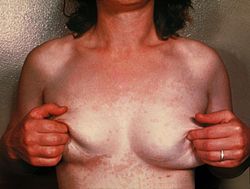Tinea versicolor
From Wikipedia, the free encyclopedia
| Tinea versicolor Classification and external resources |
|
| ICD-10 | B36.0 |
|---|---|
| ICD-9 | 111.0 |
| DiseasesDB | 10071 |
| MedlinePlus | 001465 |
| eMedicine | derm/423 |
| MeSH | D014010 |
Tinea versicolor, pityriasis versicolor or haole rot[1] is a common skin infection that was widely believed to be caused by the yeast Malassezia furfur[2] (formerly termed Pityrosporum ovale). Recent research has shown that the majority of pityriasis versicolor is caused by Malassezia globosa, although M. furfur is responsible for a small number of cases[3][4]. These yeasts are normally found on the human skin and only become troublesome under certain circumstances, such as a warm and humid environment, although the exact conditions that cause initiation of the disease process are poorly understood[5][6].
The condition pityriasis versicolor was first identified in 1846.[7]
Contents |
[edit] Symptoms
The symptoms of this condition include:
- Generally oval or irregularly-shaped spots of 1/4 to 1 inch (0.5 to 2.5 cm) in diameter, often merging together to form a larger patch
- Occasional fine scaling of the skin producing a very superficial ash-like scale
- Pale, dark tan, or pink in color, with a reddish undertone that can darken when the patient is overheated, such as in a hot shower or during/after exercise
- Sharp border
- Sometimes severe "pin-prick" itching in the affected areas; usually when the person's body temperature is elevated by exercise or a hot/warm environment, but the person hasn't started sweating yet. Once sweating begins the "pin-prick" itching stops.[citation needed]
These spots commonly affect the back, underarm, upper arm, chest, lower legs, and neck. Occasionally it can also be present on the face. The yeasts can often be seen under the microscope within the lesions and typically have a so called "spaghetti and meat ball appearance"[8] as the round yeasts produce filaments.
In people with dark skin tones, pigmentary changes such as hypopigmentation (loss of color) are common, while in those with lighter skin color, hyperpigmentation (increase in skin color) are more common. These discolorations have led to the term "sun fungus".[9]
[edit] Prevalence
Tinea versicolor is a common condition. It is estimated that 2 to 8% of the population of the United States has it. This skin disease commonly affects adolescents and young adults, especially in warm and humid climates. It is thought that the yeast feeds on skin oils (lipids) as well as dead skin cells. Infections are more common in people who have seborrheic dermatitis, dandruff, and hyperhidrosis[10].
[edit] Treatment
Treatments for tinea versicolor include:
- Topical antifungal medications - containing either 2.5% selenium sulfide (Selsun shampoo in UK, but not Selsun Blue which contains only 1%) or 2% ketoconazole (Nizoral ointment and shampoo) applied to dry skin and washed off after 10 minutes, repeated daily for 2 weeks[11]. Ciclopirox (Ciclopirox olamine) is an alternative treatment to ketoconazole as it suppresses growth of the yeast Malassezia furfur. Initial results show similar efficacy to ketoconazole with a relative increase in subjective symptom relief due to its inherent anti-inflammatory properties [12]. Other topical antifungal agents such as clotrimazole, miconazole or terbinafine are less widely recommended. Additionally, hydrogen peroxide has been known to lessen symptoms, and on certain occasions, remove the problem.[citation needed] Clotrimazole (1%) is also used combined with selenium sulfide (2.5%) (Candid-TV).
- Oral antifungal prescription-only medications include 400 mg of ketoconazole or fluconazole in a single dose, or ketoconazole 200 mg daily for 7 days, or itraconazole[13][14] 400 mg daily for 3-7 days. The single-dose regimens can be made more effective by having the patient exercise 1-2 hours after the dose, to induce sweating. The sweat is allowed to evaporate, and showering is delayed for a day, leaving a film of the medication on the skin.[citation needed]
- Some success with Cassia alata has been reported.[15]
- Recurrence is common and may be reduced by intermittent application of topical agents (such as tea tree oil) or adding a small amount of anti-dandruff shampoo to water used for bathing.
[edit] External links
[edit] References
- ^ http://the.honoluluadvertiser.com/article/2007/Apr/19/il/FP704190309.html The Honolulu Advertiser: What is haole rot?
- ^ tinea versicolor at Dorland's Medical Dictionary
- ^ Morishita N; Sei Y. Microreview of Pityriasis versicolor and Malassezia species. Mycopathologia. 2006 Dec;162(6):373-6
- ^ Prohic A; Ozegovic L. Malassezia species isolated from lesional and non-lesional skin in patients with pityriasis versicolor. Mycoses. 2007 Jan;50(1):58-63.
- ^ Morishita N; Sei Y. Microreview of Pityriasis versicolor and Malassezia species. Mycopathologia. 2006 Dec;162(6):373-6
- ^ Weedon, D. 2002. Skin pathology. 2nd Ed. Churchil Livingstone. ISBN 0-443-07069-5
- ^ Inamadar AC, Palit A (2003). "The genus Malassezia and human disease". Indian J Dermatol Venereol Leprol 69 (4): 265–70. PMID 17642908. http://www.ijdvl.com/article.asp?issn=0378-6323;year=2003;volume=69;issue=4;spage=265;epage=270;aulast=Inamadar.
- ^ "Adolescent Health Curriculum - Medical Problems - Dermatology - Papulosquamous Lesions (B4)". http://www.usc.edu/student-affairs/Health_Center/adolhealth/content/b4derm4.html. Retrieved on 2008-12-10.
- ^ "Tioconazole (Topical Route) - MayoClinic.com". http://www.mayoclinic.com/health/drug-information/DR601345. Retrieved on 2008-12-10.
- ^ Weedon, D. 2002. Skin pathology. 2nd Ed. Churchil Livingstone. ISBN 0-443-07069-5
- ^ MedlinePlus Medical Encyclopedia: Tinea versicolor
- ^ Ratnavel RC, Squire RA, Boorman GC (2007). "Clinical efficacies of shampoos containing ciclopirox olamine (1.5%) and ketoconazole (2.0%) in the treatment of seborrhoeic dermatitis". J Dermatolog Treat 18 (2): 88–96. doi:. PMID 17520465.
- ^ Faergemann J, Gupta AK, Al Mofadi A, Abanami A, Shareaah AA, Marynissen G (January 2002). "Efficacy of itraconazole in the prophylactic treatment of pityriasis (tinea) versicolor". Arch Dermatol 138 (1): 69–73. PMID 11790169. http://archderm.ama-assn.org/cgi/pmidlookup?view=long&pmid=11790169.
- ^ Mohanty J, Sethi J, Sharma MK (2001). "Efficacy of itraconazole in the treatment of tinea versicolor". Indian J Dermatol Venereol Leprol 67 (5): 240–1. PMID 17664760. http://www.ijdvl.com/article.asp?issn=0378-6323;year=2001;volume=67;issue=5;spage=240;epage=241;aulast=Mohanty.
- ^ Damodaran S, Venkataraman S (March 1994). "A study on the therapeutic efficacy of Cassia alata, Linn. leaf extract against Pityriasis versicolor". J Ethnopharmacol 42 (1): 19–23. PMID 8046939. http://linkinghub.elsevier.com/retrieve/pii/0378-8741(94)90018-3.
|
|||||||||||||||||||||||||||||||||||||||||||||||||||||||||||||||||||||||||||
|
|||||||||||||||||||||||



